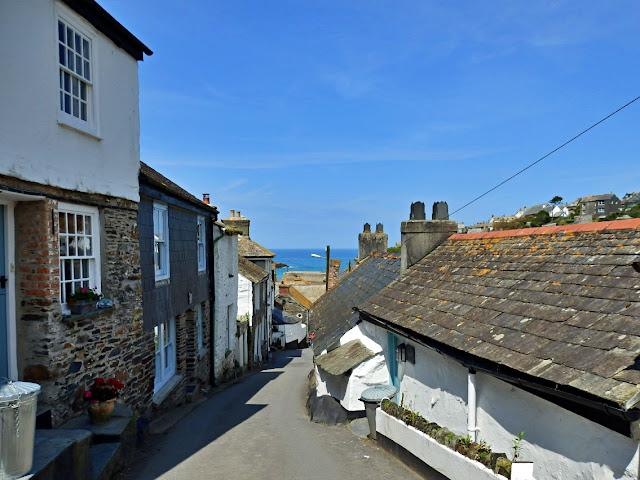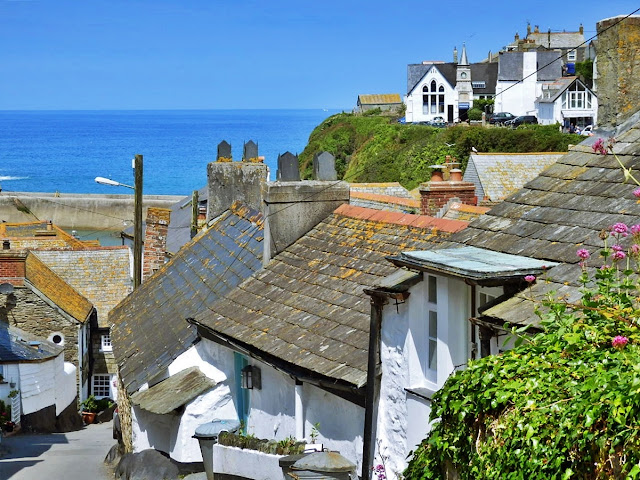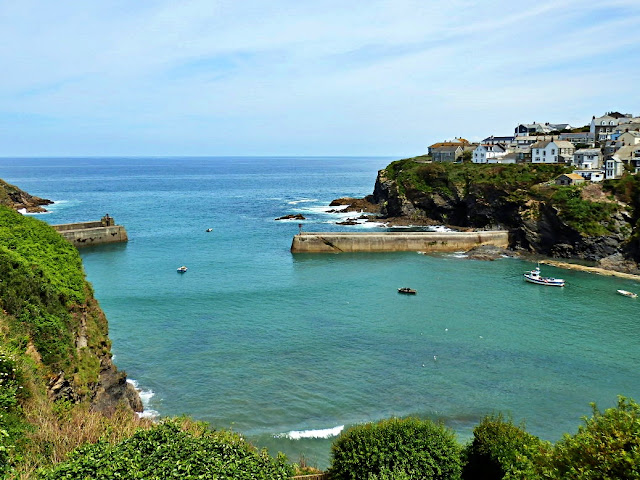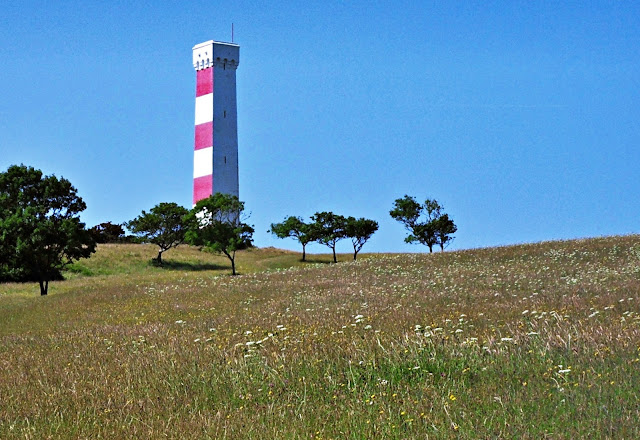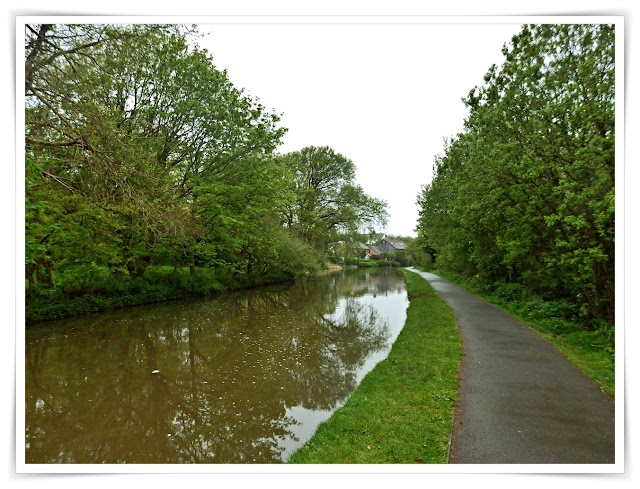Saturday, 8 June 2019
A Trip Around Port Isaac, Cornwall - The Home of Doc Martin's Portwenn
This is a visit we made to the lovely Cornish village of Port Isaac. It has become quite famous since the Doc Martin television series, starring Martin Clunes, was filmed and based here under the name of Portwenn. It is also the home of the Fisherman's Friends singers.
We parked the car at the top of the village and walked down to Port Isaac harbour. The sea around Cornwall seems quite magical as it changes to various shades of colour. Houses are perched on the hillsides
By the harbour there are a few shops ...
... and The Krab Pot cafe.
The harbour has a small beach dependent on the tide. Looking upwards, it's possible to see Doc Martin's house. I have put a red dot on it's roof.
Looking out to the Port Isaac harbour walls and ...
... now looking inland from the beach.
There's a path leading up to the cliff side houses and a walk beyond.
There are lovely views over Port Isaac from the path and ...
... you pass Doc Martin's house (photo below).
After walking quite a way, we retraced our steps going down the path - with those lovely views.
Reaching sea level again we meandered through the village cottages.
There's a lot of up and down in the village. The photo below shows why it's advisable to park cars at the top of the village - the roads are very narrow ...
... and can be quite steep.
A last look at the harbour before making our way back to the car. Always an interesting place to visit but it does get busy in the main season because of the popularity of Doc Martin. We saw many people visiting from other countries.
Thursday, 6 June 2019
The Owl Sanctuary and Reflections Of An Owl's Eye
A while back there were owls in our local town. They were from the Screech Owl Wildlife Park near Indian Queens, Cornwall. As I had my camera with me I snapped a few photos and put some money in their bucket.
One of the photos really caught my eye - as I saw my own reflection in the owl's eye! Not a very elegant pose.
The Screech Owl Sanctuary isn't some sort of zoo for birds, they have admirable aims. To quote from their website:
One of the photos really caught my eye - as I saw my own reflection in the owl's eye! Not a very elegant pose.
The Screech Owl Sanctuary isn't some sort of zoo for birds, they have admirable aims. To quote from their website:
# To provide care and rehabilitation for sick and injured wild owls in Cornwall. To ensure their safe release into the wild on recovery or, if permanently disabled, to provide a comfortable home in a suitable environment.
# To promote awareness of the conservation needs of owl species and their natural habitats by working with schools, youth organisations, groups and individuals of all ages.
More information on their website.
Indian Queens
The name Indian Queens, for the local village, is named after a picture which was once in an old Inn or Pub which stood beside the road leading to Goss Moor.
Some say the Picture was of Pocahontast, others say it was of Queen Victoria - who was Queen of India. But, whatever. you'll find the Screech Owl Wildlife Park at Goss Moor, near Indian Queens.
Tuesday, 4 June 2019
Growing Apple Tree From A Pip - Plus Cornwall's Eden Project
Oh, me of little faith!
Eight years ago my wife planted an apple pip in a small pot.
"Why?" I asked. "So we can have an apple tree," she answered.
"Yes, but couldn't we just buy one?"
"Ah," she replied, "but I like the flavour of this apple."
"Okay, okay!"
Over time the pip began to shoot and became, what I called a twig."
"No, no!" she said it's an apple tree."
And so it went on year after year, but I had to admit that the bush or tree, or whatever it was, gradually got bigger - but not a flower or an apple did it produce.
Last year I threatened to dig it up. "No, no!" she cried." Okay, there weren't actually any tears but I did say one more year and that's it - full stop!
This year all was silent in the house when I heard much excitement, "It's got flowers, the apple tree has got flowers!"
"Oh, great," I mumbled with as much enthusiasm as a damp squid. "It doesn't mean that there will be apples," I said in my best know-it-all tone of voice.
But now, today, I have to admit that there could well be apples growing on the pip tree - at least a dozen or so - the photo at the top of this post shows some of the evidence.
Now I know that Aristotle said that: "One swallow does not a summer make, nor one fine day; similarly one day or brief time of happiness does not make a person entirely happy."
I told my wife this but she said, "What on earth are you rambling on about, what's that got to do with apples? There will be apples on the tree, just you wait and see."
So I'm waiting to see. The proof will be in the eating of the apple pie!
On the approach to the car parks there were beautiful fields of wild flowers.
Once inside the Eden Project we walked round the gardens to see some of the various flowers on display.
After meandering through flower gardens we headed for the Mediterranean Biome - can just see a glimpse of it in the photo below.
We only had a quick walk round the biome as there were so many people everywhere - children were on half term, so lots of visitors to Eden at such times. Just a couple of quick photos from the Mediterranean Biome.
And finally a few people below getting their first look at some of the biomes - always an impressive sight.
Luckily we have annual passes, so can often visit the Eden Project, preferably when it isn't quite so busy.
Also see:
Flavour of Cornwall's Eden Project - 15 photos
More Flavour of Cornwall's Eden Project - 14 photos
Eight years ago my wife planted an apple pip in a small pot.
"Why?" I asked. "So we can have an apple tree," she answered.
"Yes, but couldn't we just buy one?"
"Ah," she replied, "but I like the flavour of this apple."
"Okay, okay!"
Over time the pip began to shoot and became, what I called a twig."
"No, no!" she said it's an apple tree."
And so it went on year after year, but I had to admit that the bush or tree, or whatever it was, gradually got bigger - but not a flower or an apple did it produce.
Last year I threatened to dig it up. "No, no!" she cried." Okay, there weren't actually any tears but I did say one more year and that's it - full stop!
This year all was silent in the house when I heard much excitement, "It's got flowers, the apple tree has got flowers!"
"Oh, great," I mumbled with as much enthusiasm as a damp squid. "It doesn't mean that there will be apples," I said in my best know-it-all tone of voice.
But now, today, I have to admit that there could well be apples growing on the pip tree - at least a dozen or so - the photo at the top of this post shows some of the evidence.
Now I know that Aristotle said that: "One swallow does not a summer make, nor one fine day; similarly one day or brief time of happiness does not make a person entirely happy."
I told my wife this but she said, "What on earth are you rambling on about, what's that got to do with apples? There will be apples on the tree, just you wait and see."
So I'm waiting to see. The proof will be in the eating of the apple pie!
And there's more:
Thought I'd better add a few photos to this post, so here are some flower pics from a visit to Cornwall's Eden Project a few days ago.On the approach to the car parks there were beautiful fields of wild flowers.
Once inside the Eden Project we walked round the gardens to see some of the various flowers on display.
After meandering through flower gardens we headed for the Mediterranean Biome - can just see a glimpse of it in the photo below.
We only had a quick walk round the biome as there were so many people everywhere - children were on half term, so lots of visitors to Eden at such times. Just a couple of quick photos from the Mediterranean Biome.
And finally a few people below getting their first look at some of the biomes - always an impressive sight.
Luckily we have annual passes, so can often visit the Eden Project, preferably when it isn't quite so busy.
Also see:
Flavour of Cornwall's Eden Project - 15 photos
More Flavour of Cornwall's Eden Project - 14 photos
Sunday, 2 June 2019
Walking to Gribbin Head Cornwall - Daphne du Maurier Country
A visit we made - well, one we do often - to Gribbin Head with it's Gribbin tower. This is such a lovely stretch of coastline and one which inspired the writer Daphne du Maurier to write books such as Rebecca.
We parked the car at Menabilly and walked through the fields to Polridmouth - the beach above - and also the ornamental lake as below.
During the second world war Polridmouth was used as a decoy site. Lights were placed around the ornamental lake to lure enemy bombers away from nearby Fowey harbour, particularly during the build up to the D-Day invasion when 2,000 American troops were stationed in and around Fowey town.
I digress! We were actually walking to Gribbin Head and to Gribbin tower - that's the tower in the photo below.
It's a bit of a hill to climb but worth it for the views.
Gribbin Head has been an important lookout for many centuries. Iron Age people and medieval farmers settled on this viewpoint.
In Elizabethan times the Gribbin was a beacon site which, in 1588, helped carry the news to London of the approaching Spanish Armada.
Since 1832 the Gribbin (tower) has been an 84 ft. daymark to enable ships and other craft to pinpoint the approach to Fowey's harbour.
The detail below is over the door into the Gribbin.
There are lovely views and it's possible to continue walking along the coast path for many miles.
The photo below shows the entrance to the Fowey River and the harbour beyond. This is the entrance often missed by ships prior to the daymark being built.
Walking down the hill the views continue.
It's interesting that prior to 1988 the brow of the Gribbin was covered in dense scrub. Since then cattle grazing has been introduced and the grassland is now herb rich. In summer there is a variety of wild flowers and plants to be found.
I love this stretch of coast, such wonderful views and it's an essential place for any Daphne du Maurier fans to visit. The area brings her books alive.
See Also:
The Wonderful Coastline At Menabilly - Daphne du Maurier Country
Daphne Du Maurier Featured On Large Cornish Mural
Beyond The Beacon Near Du Maurier's Manderley / Menabilly
Thursday, 30 May 2019
Walking The Cliffs In North Cornwall - 14 Photos
I like walking along cliff tops, not too sure why as I'm not quite so good at heights nowadays. Somehow though I feel in tune with the cliffs and the sea vistas - if that doesn't sound to fanciful.
We were on Cornwall's north coast and set out walking from Compass Point heading towards Widemouth Bay.
The tide was out so lots of views of rocks and stones far into the distance.
We met a few others walking along the cliff tops, but not too many as it was quite a breezy day.
In the photo below you might just be able to make out two men on the rocks below - to the left of the photo. It's easy to get cut off if you don't treat the tides with respect.
The surface of some of the cliff top walk is covered in grass - so makes the walking quite comfortable other than the path goes up and down.
The cliffs seemed to get higher ...
... quite a drop. Birds nest in the cliffs safe from walkers.
A few flowers cling to the cliff tops.
Inland there were now houses to be seen and green fields with a few horses.
We reached Trig Point (below) and then continued past Efford Ditch. We carried on walking but then realised it must be nearly three miles back to the car - so we turned around and retraced our footsteps.
A trig Point, by the way, is used in the UK to mount and centre a theodolite used to take angular measurements to neighbouring trig points.
It started to drizzle with rain so we were glad to see Compass Point again.
By the time we reached Compass Point - the round building in the photo below - the rain had fortunately ceased.
Compass Point is a former coastguard lookout and was built in 1840 but was moved to it's current position in 1880. It is made from local sandstone and the design is said to be based on the Tower of the Winds in Athens. As you can see, in the photo below, it has the points of the compass on each of its octagonal sides.
Tuesday, 28 May 2019
The Canal at Bude, Cornwall Built In 1825.
When visiting Bude I was fascinated by the canal, which has only two locks. It's no longer used for carrying goods but there are a few pleasure craft on the water - photo above.
The three photos below show the lock and some of the workings at the Bude harbour end of the canal.
As I understand it plans were made to create a canal way back in 1774. The local sand is full of minerals and is used by farmers as a soil conditioner and enhancer. However the plans for the canal were thwarted until an Act of Parliament was obtained in 1819 giving permission for the work to begin.
The first 35 miles of canal were completed by 1825 and there were high hopes of big profits carrying sand and other goods.
The building of the canal was quite a feat as it had, as mentioned, only two locks and also six inclined planes.
It became the first canal in the UK and second in the world to use water-powered tub-boat inclines, and it had the most inclined planes of any waterway.
Now I don't profess to fully understand inclined planes so I think I'll have to quote from Wikipedia :
"The unusual feature of the canal was the six inclined planes. The tub boats had wheels, and on the inclined planes they were pulled up the slopes with the wheels running in channel rails (like a squat letter "U" in section). There were two sets of rails, one for each direction, but it does not appear that a counterbalancing system was used (in which a boat coming down would balance one being pulled up).
The tub boats were hauled up and let down the inclined planes by chains, which were operated in most cases by waterwheels; the transit took five minutes or so."
Once completed the canal cut the cost of sand by as much as three-quarters. All well and good until, that is, the railway arrived in Bude in 1898. Those big expected profits never materialised. Today the canal looks very attractive and there is a walkway running alongside for walkers and cyclists - as photo above. Unfortunately it was raining when we walked along the path but there is much to see. There are some attractive old cottages, as below, and so on.
Off to the side, at the Bude end, there are nature reserves for birds and other wild life.
We had a pleasant walk alongside the canal despite the rain. Several men were fishing - they need a licenc. There was no sign of any catches, but they seemed happy enough!
More information on the Bude Canal can be found on the Bude Canal and Harbour Society website.
Subscribe to:
Posts (Atom)
FEATURED POST
Cornwall's Lizard Peninsula
I know my wife and I and live in Cornwall but we had a break away from home on Cornwall's L izard Peninsula - one of our favourit...
















